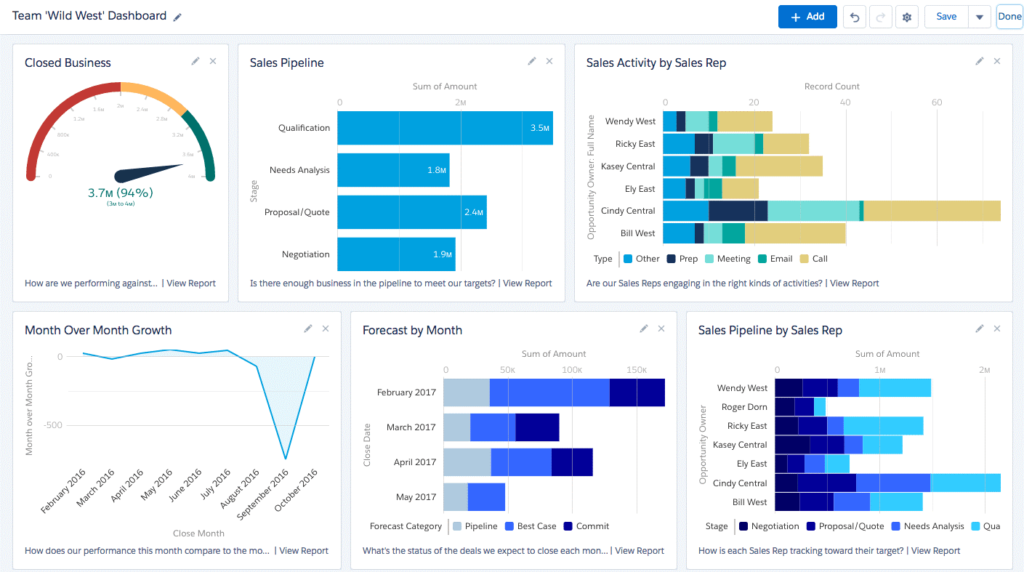Hello there! Welcome to my very first article on the Knowledge Center Blog! In this post, I will walk on the feet of sales teams, and help them overcome a major challenge: the overwhelming amount of data that we have available today, which makes it almost impossible to make updated intelligent decisions!
So, as we know, one of the biggest concerns that sales reps face daily is the immense amount of information available. It seems almost impossible to analyze, interpret and make smart decisions with all the available data, as we just might get lost in it.
Sales Key Performance Indicators
In order to help sales reps manage their business in a more efficient way, I suggest they use Sales Key Performance Indicators (Sales KPIs). But what are these Sales KPIs?
Sales KPI is a measurable value that represents an individual’s, team’s, or company’s performance. These measures help in optimizing your sales performance, sales funnel, and sales cycle length so you can better track progress towards your company’s goals, prepare for future growth, adjust sales compensation, award incentives and bonuses, and identify strategic issues.
Important Sales KPIs
Here are some of the most important metrics that Sales reps can use:
- Sales Growth: This is an indicator based on an assessment of your actual revenue versus your forecast revenue. From this indicator is expected that your actual revenue outperforms your forecast in order to achieve your goals.
- Average Revenue per Unit: This KPI indicates the average customer’s revenue from all your sales per month. Comparing this metric with the acquisition costs helps you have a better overview of if you are making any profits from your revenue. From this indicator is expected you have a rising curve, meaning you are signing not only more customers but better deals.
- Customer Churn Rate: Not all indicators focus on the revenue you bring to the company. It is also important to know what you are losing. The customer churn rate expresses the number of customers who stopped using your company’s products. This indicator gives you an overview of the customers and revenue you will lose and how to develop a retention strategy to stop that loss.
- Lead-Opportunity: This one is a key metric of your sales pipeline. You can understand where your quality leads are source from and guide your marketing/sales team better. You can calculate your lead conversion rate to check your goals and understand if your sales pipeline is in a good shape or not. Finally, you can also check the number of new sales opportunities (potential purchase) and your opportunity win rate. By monitoring the number of new sales opportunities and their potential purchase value as well as the conversion rate you can identify the bottlenecks in your sales funnel at an early stage.
The Magic Tool: Salesforce
The question and stake, and one of the main focuses of this post, is to answer the following: “Is there any tool to help you implement all your Sales KPIs in your business in a simple way?”. Well, there is!
First, let me tell you what Salesforce is all about! It consists of a customer relationship management solution (CRM) that gives a single shared view of every customer to your entire company. It consists of a cloud platform where you can store all your client’s information easily accessed from wherever you are.
Fortunately, as the largest web-based platform, Salesforce presents unique selling points. Here are the ones I find most significant:
- Flexibility: Salesforce presents an environment more flexible than other similar systems on the market where you can build a solution in line with your own needs at any time.
- User-Friendliness: Salesforce possesses a very user-friendly interface. Has a big or small company you don’t have to be a Tech Guru to be able to implement changes on the administration level. In addition, Salesforce has a very large community and a learning program named Trailhead where you can acquire administrator skills by doing easy modules.
- AppExchange: Another major benefit of Salesforce is the AppExchange feature where you can acquire already built apps capable of supporting your processes like recruitment, sales, marketing, finance, and others. In opposition to some competitors, where you are obliged to settle for integrated tooling from the same supplier, the AppExchange has app developed by experts from all different companies which leads to a variety of solutions.
- Standard API links: In case Salesforce standard solutions don’t solve your problem, you have the possibility to use separate applications to which you can link up with your Salesforce environment (e.g. Hubspot, Act-On, Eloqua, and Marketo).
The Sales Cloud
Salesforce, as a high-quality CRM solution, has a large range of different services available like Commerce Cloud, Sales Cloud, Service Cloud, Marketing Cloud, and so on…

In this article, I will focus on Sales Cloud, the tool developed by the #1 CRM in the world, thinking about the sales teams. This solution has a variety of standard solutions that can help your business grow. With the account and contact standard objects you can have a 360º view of your customers. You can organize your accounts and combine them with the respective contacts. You can also create events or schedule tasks and merge them with any type of record so you can manage your deals more efficiently. These are highly valuable information and possibilities for sales teams, which are empowered by a tool that makes their work more efficient and allows them to achieve better results at a faster pace.
Other Standard Features of Sales Cloud is the Opportunity and Lead Management. Here you can differentiate your potential deals that are not yet a client from the deals that you have in progress and are already a client, so you can work both in a different and personalized way, to achieve better and more suitable results.
In the Lead, Salesforce also allows you to customize your lead processes, so you have different processes for different lead sources. You can create different stages and rearrange the information along the sales process to offer more guidance to your sales reps. Always route and assign leads to the right people, so you have all the time the right sales reps follow up the leads when they are “hot”. Let your marketing team focus on tracking the campaigns to have better accurate forecasting about the potential deals you might get with your campaigns.
With Opportunity management, you can have a complete view of your team’s deals. You can easily customize the sales process the way you want so you can drive the process, productivity, shorten your sales process, giving your reps more time to focus on the right opportunities to help grow your business.
Combining these features with the standard mobile app, you can view critical details, the stage, products, quotes of each deal, among other crucial data. You can send emails, track all associated activities, and receive updates when an action is needed. All the information you need to help you close deals faster is just one click away, see?
But with all these features described previously where do the Sales KPIs enter?
Salesforce creates customizable reports and dashboards (as you may see below) with all the information you and your sales reps want and need! Here you can look at the settled Sales KPIs and have an overview of your current status towards your company’s goals. For example, see who your best sales rep is, which deals are giving more revenue, among so many others.

I hope you have found this article useful! If you are in Sales, join Salesforce and the trailblazer community and see your business grow! Besides, I do invite you to subscribe to Stellaxius Blog, Knowledge Center! 🙂
SUBSCRIBE KNOWLEDGE CENTER
Subscribe for free to our Knowledge Center to get the latest articles straight to your inbox!







